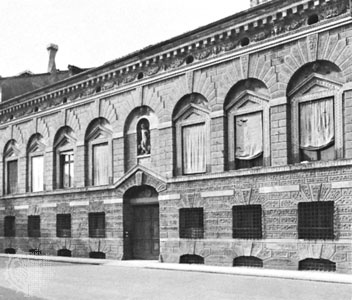Giulio Romano
Italian artist and architect
original name Giulio Pippi, in full Giulio di Pietro di Filippo de' Gianuzzi
born 1492/99, Rome 【Italy】
died Nov. 1, 1546, Mantua, Duchy of Mantua
late Renaissance painter and architect, the principal heir of Raphael, and one of the initiators of the Mannerist (Mannerism) style.
Giulio was apprenticed to Raphael as a child and had become so important in the workshop that by Raphael's death, in 1520, he was named with G. Penni as one of the master's chief heirs; he also became his principal artistic executor. After Raphael's death, Giulio completed a number of his master's unfinished works, including the Transfiguration. In his original work from these years, such as the Madonna and Saints (c. 1523) and the Stoning of St. Stephen (1523), Giulio developed a highly personal, anticlassical style of painting.
In 1524 Giulio left Rome for Mantua, where he remained until his death, completely dominating the artistic affairs of that duchy. The most important of all his works is the Palazzo del Te, on the outskirts of Mantua, begun in 1525 or 1526 and built and decorated entirely by him and his pupils. This palace is almost a parody of the serene classicism of Donato Bramante (Bramante, Donato) while retaining the forms of Roman antiquity. The building consists of a square block around a central court with a garden opening off at right angles to the main axis—in itself characteristic of the way in which all the elements are slightly different from what would be expected. The design is particularly famous for its capricious misuse of ancient Greek and Roman ornamental motifs.
The principal rooms of the Palazzo del Te are the Sala di Psiche, with erotic frescoes of the loves of the gods; the Sala dei Cavalli, with life-size portraits of some of the Gonzaga horses; and the fantastic Sala dei Giganti. This showpiece of trompe l'oeil (illusionistic) decoration is painted from floor to ceiling with a continuous scene of the giants attempting to storm Olympus and being repulsed by the gods. On the ceiling, Jupiter hurls his thunderbolts, and the spectator is made to feel that he, like the giants, is crushed by the mountains that topple onto him, writhing in the burning wreckage. Even the fireplace was incorporated into the decoration, and the flames had a part to play. This room was completed by 1534, with much help from Rinaldo Mantovano, Giulio's principal assistant. The colour is very crude; the subject is suited to facile virtuosity and tends to bring out the streak of cruelty and obscenity that runs just below the surface in much of Giulio's painting.
 In Mantua itself he did a great deal of work in the huge Reggia dei Gonzaga. The decorations of the Sala di Troia are particularly noteworthy in that they look forward to the illusionistic ceiling decorations of the Baroque; this style was probably inspired by the presence in Mantua of the Camera degli Sposi by Andrea Mantegna (Mantegna, Andrea). Giulio also built for himself a Mannerist version of the House of Raphael (1544–46) and began the rebuilding of the cathedral (1545 onward).
In Mantua itself he did a great deal of work in the huge Reggia dei Gonzaga. The decorations of the Sala di Troia are particularly noteworthy in that they look forward to the illusionistic ceiling decorations of the Baroque; this style was probably inspired by the presence in Mantua of the Camera degli Sposi by Andrea Mantegna (Mantegna, Andrea). Giulio also built for himself a Mannerist version of the House of Raphael (1544–46) and began the rebuilding of the cathedral (1545 onward).Additional Reading
Frederick Hartt, Giulio Romano, 2 vol. (1958, reissued 1981, 2 vol. in 1).
- The Chase Manhattan Corporation
- the Chemical Brothers
- The Christian Science Monitor
- the Cid
- The Citadel
- the Clash
- The Cloisters
- the Coasters
- The Coca-Cola Company
- The Cockpit
- thecodontian
- The Comedy of Errors
- The Commercial Appeal
- The Communist Manifesto
- The Complete Peerage
- The Cosby Show
- The Courier-Journal
- The Crisis
- the Cumbraes
- The (CUNY) City University of New York
- The Curragh
- Theda Bara
- The Daily Telegraph
- The Dalles
- The Deseret News